Getting really fed up with all the over protective parenting going on.
Hold my hand, don't go near the edge, watch your step going up the stairs....
Just leave the little brats at home if you are so bloody scared of them scraping a knee.
The smaller castles in Cumbria didn't get many visitors and I often had the place to myself. These world heritage site castles are teeming with visitors.
Bloody foreigners, they have to go back....
Castle review thread.
-
Montegriffo

- Posts: 18852
- Joined: Wed Nov 30, 2016 7:14 am
Re: Castle review thread.
Death, death, to the IDF.


-
Montegriffo

- Posts: 18852
- Joined: Wed Nov 30, 2016 7:14 am
Re: Castle review thread.
Beaumaris, the last and greatest of the castles built by James of St George for Edward the first.

Unlike Flint or Rhuddlan, which were designed by other Master masons and only finished by James, Beaumaris was all his from the start.
Unlike Conwy or Caenarfon, which James planned and built, Beaumaris is located on flat ground surrounded by salt marshes. No restrictions due to being built on rocky outcrops or around an existing castle James was able to create a perfectly symetrical, state of the art fortress.
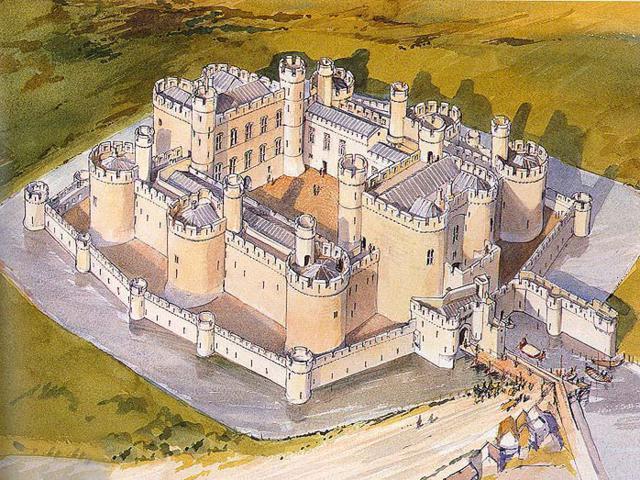
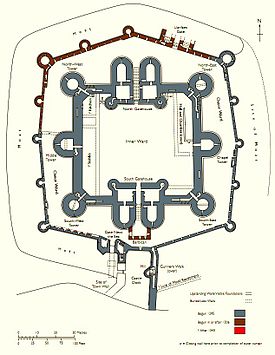
Much of Beaumaris still stands, the concentric walls and the shells of the 6 huge mural towers with their connecting walls stand proud.

This is the first castle I've seen on this trip which has a wet moat. I started with a walk around the three remaining sides of the Irish sea fed defence.

This place has long been on my wish list of places to see and it did not disappoint.
Once through the outer wall's gatehouse you enter the perfect killing field between the inner and outer wards. The outer wall has over 300 arrow loops facing both inwards and outwards. The inner wall towers above you to a huge height. This would not be a nice place to be for an attacking man at arms.
The gatehouse through to the innerward had a long corridor with 3 portcullis and at least 2 huge wooden gates. All along the walls of the corridor are arrow loops and the ceiling contained murder holes through which arrows, rocks or boiling oil could be poured down on the unlucky assailants. The true definition of the forlorn hope. Unfortunately much of the entrance gatehouse no longer stands, the opposing gatehouse was never used as an entrance so despite it being more complete it lacks these defences.
The wall you see jutting out into the moat to the right of the entrance was named gunners wall and has a platform at its end for a great seige engine.
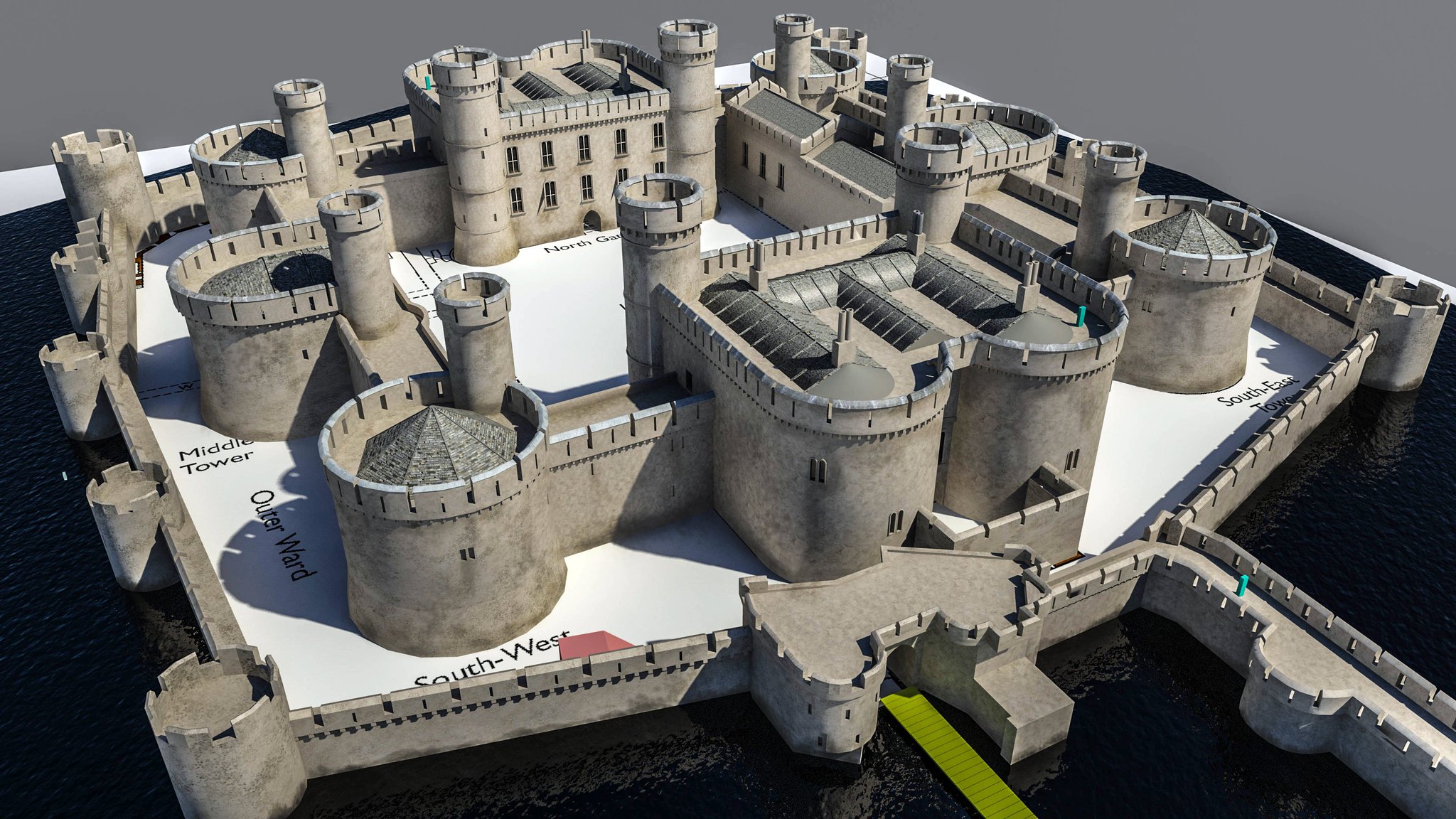

The main castle walls must be 20' thick and contain corridors leading to the numerous arrow loops and 16 separate garderobes. These corridors on several levels within the walls meant you could move archers, unseen and protected, to any part of the defences during an attack. Most are still accessable and surprisingly wide.
Both the inner and outer walls have sections which you can still walk.
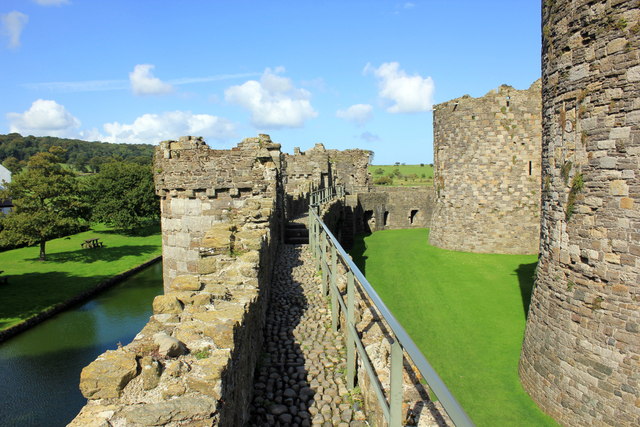

Started in 1282 work stopped after around 18 years due to Edward's exchequer running dry.
Edward's wars against the Scot's and Welsh had led to the greatest period of castle building in English history but when the masons and labourers, pulled from all over England, stopped being paid they drifted off and the castle was never fully completed.
In 1306 Work was restarted due to Edwards fear of a Scottish invasion of North Wales and continued after his death in 1307 and James' death in 1309.
Work eventually stopped in 1330 with the castle still not completed to its original plans. An extra floor, evidenced by the beginings of windows in the Southern gatehouse's top course, was never built.
Already in ruins without a dry chamber left by the 1440s the real work of restoration was begun in the 1920s when the out of control ivy was removed. This work still continues with the battle against nature requiring constant work to remove plants and re-point the masonry.
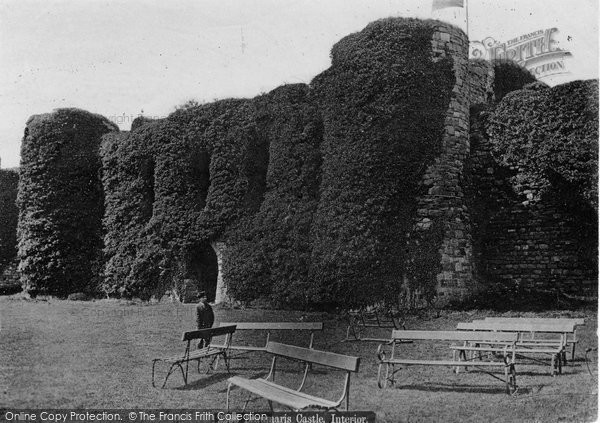
10/10 Beaumaris, if you only ever visit one English castle I recommend it is this one.







Unlike Flint or Rhuddlan, which were designed by other Master masons and only finished by James, Beaumaris was all his from the start.
Unlike Conwy or Caenarfon, which James planned and built, Beaumaris is located on flat ground surrounded by salt marshes. No restrictions due to being built on rocky outcrops or around an existing castle James was able to create a perfectly symetrical, state of the art fortress.


Much of Beaumaris still stands, the concentric walls and the shells of the 6 huge mural towers with their connecting walls stand proud.

This is the first castle I've seen on this trip which has a wet moat. I started with a walk around the three remaining sides of the Irish sea fed defence.

This place has long been on my wish list of places to see and it did not disappoint.
Once through the outer wall's gatehouse you enter the perfect killing field between the inner and outer wards. The outer wall has over 300 arrow loops facing both inwards and outwards. The inner wall towers above you to a huge height. This would not be a nice place to be for an attacking man at arms.
The gatehouse through to the innerward had a long corridor with 3 portcullis and at least 2 huge wooden gates. All along the walls of the corridor are arrow loops and the ceiling contained murder holes through which arrows, rocks or boiling oil could be poured down on the unlucky assailants. The true definition of the forlorn hope. Unfortunately much of the entrance gatehouse no longer stands, the opposing gatehouse was never used as an entrance so despite it being more complete it lacks these defences.
The wall you see jutting out into the moat to the right of the entrance was named gunners wall and has a platform at its end for a great seige engine.


The main castle walls must be 20' thick and contain corridors leading to the numerous arrow loops and 16 separate garderobes. These corridors on several levels within the walls meant you could move archers, unseen and protected, to any part of the defences during an attack. Most are still accessable and surprisingly wide.
Both the inner and outer walls have sections which you can still walk.

Started in 1282 work stopped after around 18 years due to Edward's exchequer running dry.
Edward's wars against the Scot's and Welsh had led to the greatest period of castle building in English history but when the masons and labourers, pulled from all over England, stopped being paid they drifted off and the castle was never fully completed.
In 1306 Work was restarted due to Edwards fear of a Scottish invasion of North Wales and continued after his death in 1307 and James' death in 1309.
Work eventually stopped in 1330 with the castle still not completed to its original plans. An extra floor, evidenced by the beginings of windows in the Southern gatehouse's top course, was never built.
Already in ruins without a dry chamber left by the 1440s the real work of restoration was begun in the 1920s when the out of control ivy was removed. This work still continues with the battle against nature requiring constant work to remove plants and re-point the masonry.

10/10 Beaumaris, if you only ever visit one English castle I recommend it is this one.



Death, death, to the IDF.


-
Montegriffo

- Posts: 18852
- Joined: Wed Nov 30, 2016 7:14 am
Re: Castle review thread.
I had planned to visit Caenarfon in the afternoon but there was nowhere to park my truck within a couple of miles of the place. All the car parks were full and the size of my truck meant street parking was impossible. I considered parking up on the outskirts of town and cycling in on my pushbike but the thought of the huge crowds of people wandering around the site put me off.
Instead I headed for Criccieth. A Welsh built castle, taken by the English and improved in 2 more phases of building, it stands attop an impresive rock on the coastline a few miles from Caenarfon.




The climb up the rock to the badly ruined castle was a real test for your calf muscles and from the top you could see Harlech castle on the otherside of the estuary.
Today I'm off to Harlech for my last visit before I head for Llangollen and my next gig with the kitchen...
Instead I headed for Criccieth. A Welsh built castle, taken by the English and improved in 2 more phases of building, it stands attop an impresive rock on the coastline a few miles from Caenarfon.




The climb up the rock to the badly ruined castle was a real test for your calf muscles and from the top you could see Harlech castle on the otherside of the estuary.
Today I'm off to Harlech for my last visit before I head for Llangollen and my next gig with the kitchen...
Death, death, to the IDF.


-
Montegriffo

- Posts: 18852
- Joined: Wed Nov 30, 2016 7:14 am
Re: Castle review thread.
In 1986 four of Master James' Welsh castles were granted world heritage status. This ranks them alongside places like the pyramids and the colosseum in terms of international importance.
Those four are Beaumaris, Conwy, Caenarfon and Harlech.
The short drive from Criccieth to Harlech (14 miles) along the Irish sea coast is stunning. Mountains to your left and a bright blue sea to your right. Sandy bays proliferate this bit of coastline and it is a busy holiday destination with campsites every half mile and endless hotels, guest houses and caravan parks.
Harlech castle is hard to miss, perched on a rocky outcrop it was visible from 4 miles away.

Built between 1282 and 1289 it resembles a practise run at the later Beaumaris castle. The single gatehouse bears a remarkable resemblance to the two Beaumaris gatehouses and gives us a view of what they would have looked like if they had been built to their intended height.


Built with a concentric outer wall close to the main walls its primary access was over a drawbridge and through the gatehouse corridor with its three portcullises, two massive wooden gates, arrow loops and murder holes.
A modern footbridge now takes you up to the entrance.


A steep set of about 150 wide steps cut into the rock and protected to seaward by a low wall with arrow loops descends to a gatehouse by a stone quay which was used to supply the castle from the sea. All the stores and many of the building materials would have been carried up these steps and after climbing back up them I was glad to be carrying only a guidebook.
This access to supplies to the sea meant it could withstand the 1294 seige during the uprising of Madog ap Llywelyn.

There was access to the top of the main walls through stairs in the walls and spiral staircases in the towers. Around 50-60 feet tall I would advise not looking down if you suffer from vertigo.


James of St George had a great affinity with this castle and was made constable of Harlech from 1290 until his retirement.
The castle saw further action in the rebellion of Owain Glyndwr and fell to his forces in 1404. It also saw action during the war of the Roses where it was the last
major stronghold of the Lancastrian forces. It was also the last Royalist castle to fall in the civil war after a seige lasting 9 months.
Those four are Beaumaris, Conwy, Caenarfon and Harlech.
The short drive from Criccieth to Harlech (14 miles) along the Irish sea coast is stunning. Mountains to your left and a bright blue sea to your right. Sandy bays proliferate this bit of coastline and it is a busy holiday destination with campsites every half mile and endless hotels, guest houses and caravan parks.
Harlech castle is hard to miss, perched on a rocky outcrop it was visible from 4 miles away.

Built between 1282 and 1289 it resembles a practise run at the later Beaumaris castle. The single gatehouse bears a remarkable resemblance to the two Beaumaris gatehouses and gives us a view of what they would have looked like if they had been built to their intended height.

Built with a concentric outer wall close to the main walls its primary access was over a drawbridge and through the gatehouse corridor with its three portcullises, two massive wooden gates, arrow loops and murder holes.
A modern footbridge now takes you up to the entrance.


A steep set of about 150 wide steps cut into the rock and protected to seaward by a low wall with arrow loops descends to a gatehouse by a stone quay which was used to supply the castle from the sea. All the stores and many of the building materials would have been carried up these steps and after climbing back up them I was glad to be carrying only a guidebook.
This access to supplies to the sea meant it could withstand the 1294 seige during the uprising of Madog ap Llywelyn.

There was access to the top of the main walls through stairs in the walls and spiral staircases in the towers. Around 50-60 feet tall I would advise not looking down if you suffer from vertigo.


James of St George had a great affinity with this castle and was made constable of Harlech from 1290 until his retirement.
The castle saw further action in the rebellion of Owain Glyndwr and fell to his forces in 1404. It also saw action during the war of the Roses where it was the last
major stronghold of the Lancastrian forces. It was also the last Royalist castle to fall in the civil war after a seige lasting 9 months.
Death, death, to the IDF.


-
Montegriffo

- Posts: 18852
- Joined: Wed Nov 30, 2016 7:14 am
Re: Castle review thread.
That's it for now. I'm in Llangollen preparing for the fairy fayre. Twenty castles in 12 days, not a bad run...
However Dinas bran an ancient ruined Welsh castle looks down on Llangollen from on top of a nearby hill and I also have a little treat for myself on the way back to Suffolk. See my sig for a clue...
However Dinas bran an ancient ruined Welsh castle looks down on Llangollen from on top of a nearby hill and I also have a little treat for myself on the way back to Suffolk. See my sig for a clue...
Death, death, to the IDF.


-
Montegriffo

- Posts: 18852
- Joined: Wed Nov 30, 2016 7:14 am
Re: Castle review thread.
A few of my own pics
kitchen parked on Hadrian's wall near a Roman observation tower (awning still intact)

view from my bed

Brough castle

crumbling infrastructure

kitchen parked on Hadrian's wall near a Roman observation tower (awning still intact)

view from my bed

Brough castle

crumbling infrastructure

Death, death, to the IDF.


-
BjornP

- Posts: 3360
- Joined: Thu Dec 01, 2016 9:36 am
- Location: Aalborg, Denmark
Re: Castle review thread.
Were medieval English/Scottish/Welsh peasants forbidden from salvaging stone from all those ruins? Or was there simply no great demand for stone, so the abandonded forts and castles just...kept standing?
I think we only have two medieval era fortifications or castles left standing in Denmark. The rest either got destroyed in wars, or as time grew and cannons got introduced got dismantled, and fortifications redirected to cover fewer, more strategic points across the Danish kingdom. That you have so many - more or less intact - castles left standing seems to point to just how little (compared to mainland Europe, anyway) wars you've engaged in - and/or that it was either too difficult or unnecesary to repurpose the stone from abandonded fortifications.
I think we only have two medieval era fortifications or castles left standing in Denmark. The rest either got destroyed in wars, or as time grew and cannons got introduced got dismantled, and fortifications redirected to cover fewer, more strategic points across the Danish kingdom. That you have so many - more or less intact - castles left standing seems to point to just how little (compared to mainland Europe, anyway) wars you've engaged in - and/or that it was either too difficult or unnecesary to repurpose the stone from abandonded fortifications.
Fame is not flattery. Respect is not agreement.
-
Montegriffo

- Posts: 18852
- Joined: Wed Nov 30, 2016 7:14 am
Re: Castle review thread.
Subjects certainly were forbidden to take stones from their local castles.BjornP wrote: Fri Aug 10, 2018 1:26 pm Were medieval English/Scottish/Welsh peasants forbidden from salvaging stone from all those ruins? Or was there simply no great demand for stone, so the abandonded forts and castles just...kept standing?
I think we only have two medieval era fortifications or castles left standing in Denmark. The rest either got destroyed in wars, or as time grew and cannons got introduced got dismantled, and fortifications redirected to cover fewer, more strategic points across the Danish kingdom. That you have so many - more or less intact - castles left standing seems to point to just how little (compared to mainland Europe, anyway) wars you've engaged in - and/or that it was either too difficult or unnecesary to repurpose the stone from abandonded fortifications.
Several castles did however have stones stolen and re-used elsewhere.
If you go back a page or two to Rhuddlan castle you can see that all the faced stones up to about 6' have been removed.
I think the existence of so many surviving castles is a result of many factors.
There were a hell of a lot to start with. Lots of towns no longer have a castle despite having roads called castle Street etc.
Castles were still in use right up to the civil war in the mid 17th century. They still had a military use and were maintained accordingly.
By the 18th and 19th centuries the romantic painters were taking an interest in them and their paintings kicked off the castle tourism industry which provided further incentive to maintain and even restore them.
Some castles have been in constant use since they were built and never fell into disrepair. The nearest large castle to where I am now at Chirk on the English Welsh border has been lived in by the same family for over 700 years.
Mostly they are just hard to destroy, they can lose their lead roofs and every floor timber can rot away but 10' thick walls last a long time.
Most damage was done by parliamentary forces when they captured them from the royalists in the civil war. They were ordered to be slighted or even destroyed so they could have no further military use.
Death, death, to the IDF.


-
Montegriffo

- Posts: 18852
- Joined: Wed Nov 30, 2016 7:14 am
Re: Castle review thread.
Also we did engage in plenty of wars but there have been no successful invasions since the Normans so we always fought abroad. There are great examples of English castles all over some parts of France.
Death, death, to the IDF.


-
Montegriffo

- Posts: 18852
- Joined: Wed Nov 30, 2016 7:14 am
Re: Castle review thread.
Thinking about Warwick castle on the way home.
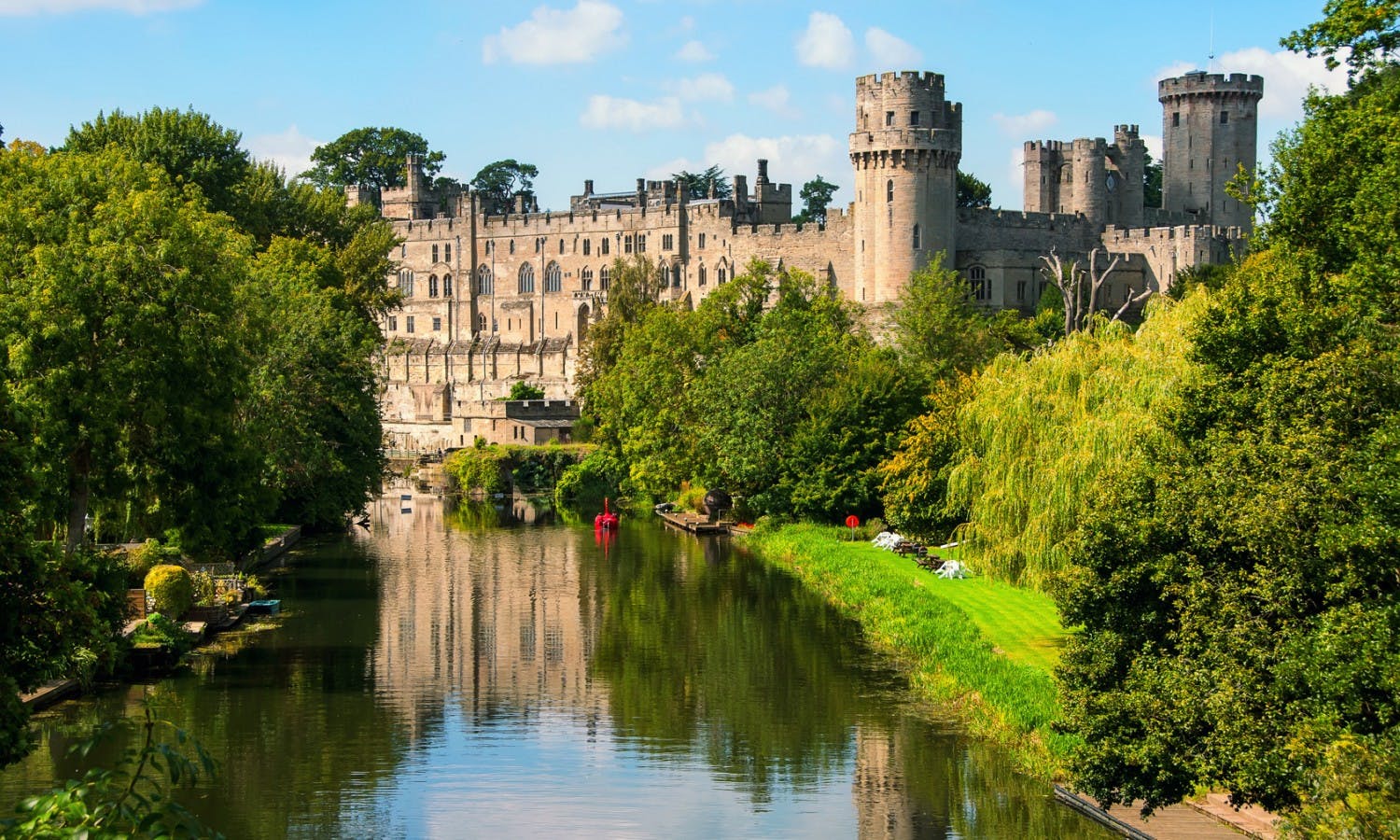
Not really my kind of castle but I haven't seen an armoury yet and their's looks good.
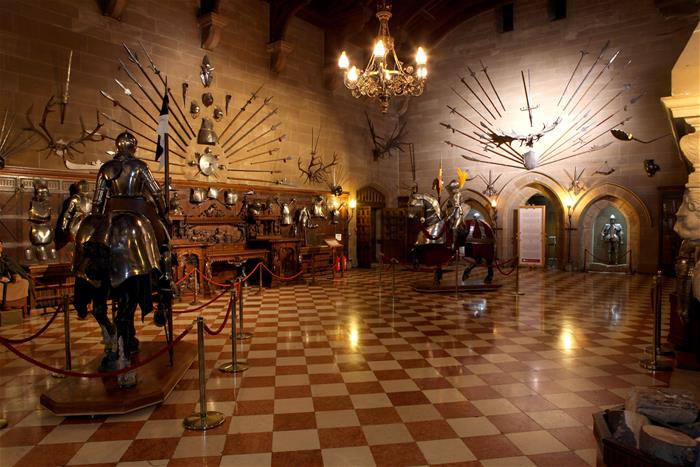
And there's the little matter of this thing out the back...

Who am I kidding? I'm going.

Not really my kind of castle but I haven't seen an armoury yet and their's looks good.

And there's the little matter of this thing out the back...

Who am I kidding? I'm going.
Death, death, to the IDF.

